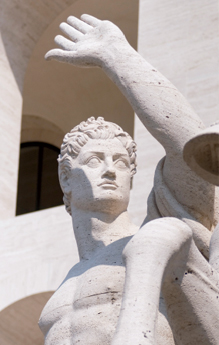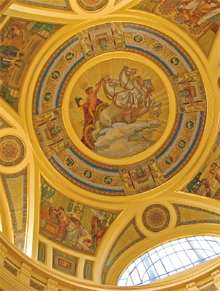Fine arts insurancePROPERTY
Alberto Vegue Rodríguezs. Transport Branch Managers. MAPFRE EMPRESAS
Background
The Spanish fine arts sector has undergone major growth over the last few years. Exhibitions, both individual or private and public (Organisations, Administrations, Foundations) have proliferated in Spain and it is not unusual for more than four or five medium sized ones to be going on at the same time.
The insurance that protects works of art has evolved similarly , bringing wide prominence to both the Transport Departments of insurance companies, which is where this insurance is channelled, and the organisers of art related exhibitions and events.
It is therefore interesting to understand a few of the specific peculiarities of fine art insurance. We also need to consider the various aspects and mechanisms of providing it.
A work of art
The applicable concept of a work of art is very extensive, since any item of artistic and/or cultural historical interest is considered as such. By way of example, although this list is not limitative, works of art may be : pictures, paintings, ceramics, porcelain, drawings, antique furniture, engravings, lithographs, photographs, tapestries, carpets, manuscripts, books, glass, sculptures, stamps or even coins forming part of a collection.
Insurance conditions
This is a very specialised type of insurance. In handling, packing, moving, installation, assembly and disassembly processes and any other type of storage, the work of art is always dealt with by professional teams of specialists working for the various organisations which transfer or receive the works. This means that in Spain this is dealt with by very few companies.
At any given moment, there is range of people or companies who may have an interest or responsibility in moving and exhibiting works of art. These are individuals who have works of art as part of their assets : companies or enterprises such as galleries, museums or public institutions, including carriers of this type of goods.
The first and most important requirement that anyone involved in fine arts insurance has to take into account is the technical and professional ability and financial solvency of the insurance company that assumes the risks, both directly and by reinsurance, and so the security “ratings” or qualifications given by specialist agencies must be taken into consideration.
The intrinsic value of works of art as unique pieces of major historical, cultural or religious significance makes it difficult to value them financially. This must be carried out by internationally qualified experts, since it will be reinsurance that assumes the largest part of the risk, providing capacity and experience.
Accuracy in identifying the insured work of art is very important and all details must be carefully and accurately explained. It is normally an essential requirement to specify the following information in the policy for each individual item, in as much detail as possible:
- Title.
- Author.
- Owner.
- Beneficiary.
- Measurements.
- Technique.
- Place of collection and return.
- Value.
Another aspect to be highlighted is the huge media impact of claims. They are widely publicised and frequently monitored and analysed by both specialists and wider social and cultural sectors in view of the high symbolic value of the insured items.
Characteristics of fine art insurance
The insurance cover taken out is the so-called “All Risks”. In other words, any risk of physical damage to or loss of the “goods” for any external cause during transport, handling and exhibiting, is insured.
The scope of cover of this insurance is usually described by the expression “nail to nail”, which means that the item is insured from the time it is moved from its original location until it is returned there. Consequently, any damage that may be occasioned to the item both during its various transport operations (packing and unpacking, handling and installation) and during the various periods it spends in the place where it is exhibited or on the premises of customs, packers and restorers, among others.
It is interesting to note that with this type of insurance, and basically due to the high sums insured involved, it is normal practice to exempt the carriers and handlers who move the items around from any liability.
provided by the English clauses of the Institute Cargo Clauses “A” of 01/01/82 or Institute Cargo Clauses Air of 01/01/82, depending on the means of transport used. However, markets specialising in Fine Art have an increasing tendency to draft special conditions tailored to these very specific risks.
This cover has very limited, specific exclusions relating almost exclusively to faulty packing, poor conditions during exhibition or inherent defects.
It is necessary to check that insurance policies covering works of art contain a few specific, concrete clauses. Some of them are as follows:
Depreciation or artistic devaluation
This covers the depreciation or devaluation that the item may suffer as a result of an insured risk, the value of the item being its maximum limit.
Set or collection
The company is liable for the cost of restoring each damaged item, but is not liable for the devaluation that may be caused to a collection or pair.
Photographs
The cost of reproducing a copy using the same technique and from the original negative is covered.
Damage to frames and protective glass
Glass breakage is not covered but damage to the work of art as a result of glass breakage is covered.
Repurchase option
Policyholders are entitled to repurchase the lost work of art if it is recovered, even if they have been paid out.
Museums
Regardless of the nature and extent of the damage, items belonging to museum collections shall continue to be the property of whoever was the owner immediately prior to the incident.
Terrorism
The risk of terrorism has increased significantly in recent times and this cover has been seriously modified basically due to the large number of works of art that accrue primarily while in museums/ galleries.
The usual practice is to provide terrorism cover during transport, but not while being exhibited in museums/galleries. However, it is possible to obtain cover during the stay by buying that specific cover in the reinsurance market. Furthermore, it is normal for policies to include this type of cover.
Exclusions
The most important ones are:
- Fair wear and tear, ageing, gradual deterioration, mould, oxidation.
- Damage from leaks, pollution or contamination.
- Inadequate or inappropriate packing or preparation of the work of art.
Valuation of works of art
The value of a work of art is a determining factor when it comes to taking out insurance and, in the vast majority of cases, is determined by its market price.
Very disparate circumstances such as the author, period in which it was produced, size, techniques and previous owners, influence its value.
It is highly recommended to insure the work for its actual market price. To ascertain its correct value, specialist publications, references obtained at art fairs, art catalogues and of course a report from an expert specialising in art can be used.
However, the item may be insured for an agreed value (less than its actual value), always established between the insured and the insurer, regardless of the value of the item. In this case, the average clause shall not apply.



